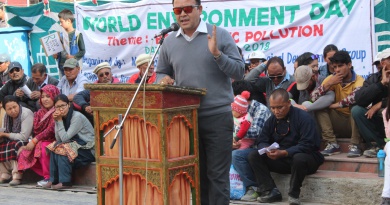Talk Series Morup Namgyal
Activity: Liveable Leh Talk Series Date: September 3, 2018 Location: LEDeG Office Meeting Hall Participants: 17
Speaker (s): Padma Shri Morup Namgyal- composer, singer and dramatist
- Objective: To highlight the importance of language, rich culture and history of Ladakh in context of today’s changing world
- Summary Agenda: September 3- Time Activity PiC 4PM Arrival of the speaker 4:05 PM Presentation of khataks and welcome speech Dr Nordan Otzer 4:15 PM Talk by the chief guest Morup Namgyal 5:30 PM Question & Answer Session 6PM Vote of thanks Tenzin Motup
- Summary of Results:
Human waste from the toilets was primary source of manure for the agricultural fields. People from Changthang area would stay at Changa and a lot of manure was produced from the cattle owned by them. The waste would then be used in fields.
How Leh got its name? There was hardly any vegetation in the rocky terrain of Leh (initially called Doa-sar), except a marshy area where the king and his ministers used to go for picnic. The peculiar thing about the place was that a large number of bubbles (leh-bey in Ladakhi) would form and hence the place was christened as Leh-bey (the land of bubbles) which was later shortened to Leh.
The Chhurpon (water supervisor) system was very popular in ancient Ladakh. They (Chhurpons) were announced through lottery. Some Chhurpons were considered auspicious if the average annual precipitation was more, and inauspicious if the rainfall/snowfall during his tenure was less. The Chhurpons had the responsibility to distribute water evenly to all the agricultural fields and he would assume his duty all through the year. Chhurpons would sit at the end of the field and check the overflow of the water. If the water reached the end of the field, the owner of the field would be penalised. Some Chhurpons were corrupt as they would release water to the fields after accepting chhang (local beer), food in return. The tenure of the Chhurpons were extended if there was flood and snowfall in that period of time. Chhurpons had a tedious task of memorising the size of the lands and had to release water to the field accordingly. The Chhurpon system is still prevalent in Saboo village.
The houses were designed so as to overcome cold in winters. The windows and doors were small, the shed for the cattle was built beneath the living room. The height of the rooms and doors were kept low to avoid loss of heat. There was also a handbook for the construction of the house which defined where to construct the kitchen, toilet, prayer room, etc. The traditional toilets did not have a door and the parents inculcated in their children the habit of throwing soil into the toilet after use.
